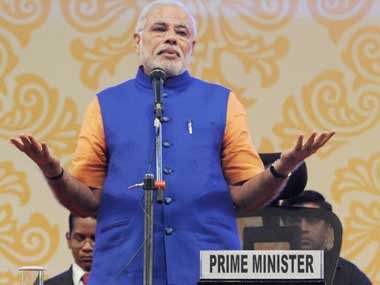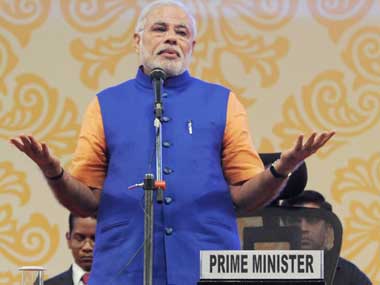One of the less noticed aspects of the latest GDP data put out by the government is that growth in the fourth quarter of 2014-15 was practically identical in terms of real growth and nominal growth (that is, GDP without adjusting for inflation).[caption id=“attachment_2288852” align=“alignleft” width=“380”]  Prime Minister Narendra Modi. Image courtesy PIB[/caption] While GDP at constant prices clocked in at 7.5 percent, GDP at current prices came in at 7.7 percent in the January-March quarter (Q4) of 2014-15. What this means is that there was nearly zero inflation during this quarter, for real GDP figures are calculated by deflating it with the estimated inflation rate. The GDP deflator, which is closer to the wholesale prices index (WPI) than retail prices, was clearly close to nil. WPI was negative all through January-March, and may continue to remain so in the coming months. This achievement contrasts sharply with the April-June quarter of 2014 (the handover month from UPA to NDA), when the gap between real and nominal GDP was as high as 6.7 percent (6.7 percent real growth versus 13.4 percent nominal). Put another way, half the growth was pure inflation. The gap started narrowing every quarter after the NDA took charge, falling to 5.2 percent in Q2, 1.5 percent in Q3 and finally to a minuscule 0.2 percent in Q4. The closing of the gap between real and nominal growth rates tells us two stories – a positive one about the NDA’s big success in killing inflation despite a weak monsoon year in 2014; and a less positive one on industry’s inability to raise prices – which is good for consumers, but bad for profitability and investment. The NDA’s biggest economic triumph has clearly been on prices, but economists tend to attribute this purely to luck – lower oil prices. But this is only half the story. The other half of the story is bad luck with the monsoon. In short, good and bad luck cancelled each other out. The NDA’s triumph is that it managed to keep food prices low in a bad monsoon year, when rainfall was down to 88 percent of the long-period average (LPA). The government managed the food economy well by releasing stocks intelligently and by keeping minimum support prices moderate. Rahul Gandhi is now using this to criticise the government as anti-farmer, but without this policy shift, inflation could have roared back in 2014-15. If the NDA continues its good work on efficient management of food prices this year, when too the Indian Met has forecast below normal rains at the exact level of last year (88 percent of the LPA), it will have negotiated two bad years in a row. Its achievements on inflation are noteworthy. The NDA’s challenge is thus less on the price front and more on the growth revival front. While corporate investment has started reviving slowly, in order to accelerate, margins have to start rising. Can NDA achieve this turnaround where corporate profits rise by enough to reignite the investment cycle, and yet not lose track of price stability? According to a report in Business Standard today (10 May), this may just be possible. The dramatic fall in input prices in 2014-15 is beginning to help, and 2015-16 should see a revival in profits – thanks, once again, to falling costs due to low inflation. Quoting a CLSA strategist, the newspaper says: “Going forward, the benefits of falling raw material costs are expected to continue, and the potential improvement in revenue growth will likely drive operating margins. Further, the expected fall in interest costs should boost net profit margins, and return on equity (RoE) should go up.” This bottoming out of corporate profitability will probably start reflecting in stock prices shortly, according to Morgan Stanley experts. The Economic Times quotes Ridham Desai, Managing Director and Head of Equity Research (India) at Morgan Stanley, as saying: “The bull market is likely to continue. Equities are in a sweet spot with a likely sharp decline in interest rates, and likely improvement in growth backed by rising government expenditure.” If the market revives after its ongoing phase of correction, it could mean two things: government will be able to collect more revenues from disinvestment, and companies themselves will be able to access the markets to bring down debts and start investing. Banks too will see an improvement in the trend towards more bad loans. Good fortune and fairly effective price management, aided by prudent monetary policies have brought India back to the point where the virtuous cycle of low-inflation, higher profitability, higher tax revenues, and higher investment may be about to begin – perhaps by the second half of 2015-16. The UPA is fond of saying that it presided over the highest growth rates ever. This is certainly true, but this growth came by chance (the upturn in the global economic cycle from 2003), and the UPA largely squandered the opportunity by eating the seedcorn instead of sowing it for the future. So what we reaped was inflation and stagnation once the party got over in 2008. UPA saw two more years of good growth, but that was on the artificial steroid of fiscal giveaways which emptied the treasury. UPA’s high growth was paid for by looting future growth prospects. Chetan Ahya, Co-head of Global Economics, Morgan Stanley, sums it up best: “The root cause of the stagflation environment had been the sharp deterioration in the productivity dynamic that resulted from the policy mistake of focusing intensely on redistribution to households, alongside a major slowdown in productive investment trend. Specifically, four policy outcomes — a sustained rise in the fiscal deficit, high rural wages growth, negative real rate environment and corruption scandals resulting in the stalling of the investment approval process, causing declines in investment — had all combined to create the toxic mix of high inflation and low growth.” Rahul Gandhi believes that the NDA government must do precisely what brought the economy to its knees, but luckily he is not in power to implement these foolhardy policies. Modi is fixing what his government broke. In one year of NDA, all the four indicators of decline are being reversed. The fiscal deficit is coming down; the quality of the fiscal deficit is also set to improve as more money goes to investment and less to subsidies; rural wage growth has hit a 10-year low earlier this year; the drop in inflation has made real interest rates positive once again (both as measured by CPI or WPI); project approval bottlenecks have been cleared; and corruption scandals at the top are down. If Ahya is right, India is on the cusp of a major economic revival under Narendra Modi. The UPA, it would appear, simply blew its chances by wasting the resources generated by growth in excessive subsidy-mongering. You can’t buy growth by redirecting productive resources towards consumption. That is the real lesson the NDA has to learn from the UPA economic-miracle-to-economic-debacle cycle over 10 years.
The NDA’s biggest macroeconomic triumph is winning the battle against inflation by intelligently managing food prices. This has laid the foundation for a revival in growth.
Advertisement
End of Article
Written by R Jagannathan
R Jagannathan is the Editor-in-Chief of Firstpost. see more


)

)
)
)
)
)
)
)
)



